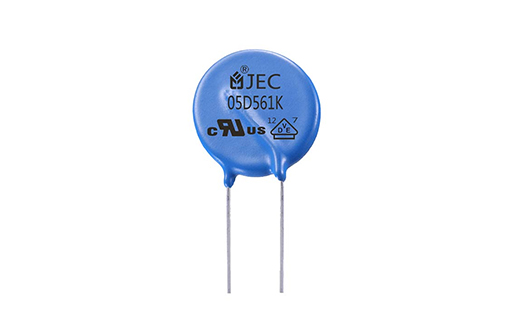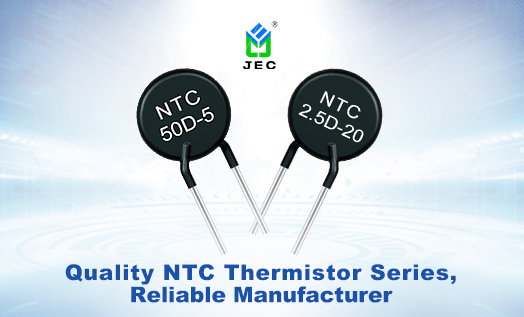Aug. 20, 2020

"Varistor" is a resistive device with non-linear volt-ampere characteristics. It is mainly used to clamp the voltage when the circuit is subjected to overvoltage and absorb excess current to protect sensitive devices. The resistor body material of the varistor is a semiconductor, which is a voltage-limiting protection device. Utilizing the non-linear characteristics of the varistor, when an overvoltage appears between the two poles of the varistor, the varistor can clamp the voltage to a relatively fixed voltage value, thereby realizing the protection of the subsequent circuit. The main parameters of varistor are varistor voltage, current capacity, junction capacitance, response time, etc.
When the voltage applied to the varistor is lower than its threshold value, the current flowing through it is extremely small, which is equivalent to a resistor with infinite resistance. In other words, when the voltage applied to it is lower than its threshold, it is equivalent to an off-state switch.
When the voltage applied to the varistor exceeds its threshold, the current flowing through it increases sharply, which is equivalent to a resistor with infinite resistance. In other words, when the voltage applied to it is higher than its threshold, it is equivalent to a closed switch.
(1) It must be ensured that the continuous working voltage will not exceed the maximum allowable value when the voltage fluctuation is maximum, otherwise, the service life of the varistor will be shortened;
(2) When a varistor is used between the power line and the ground, sometimes the voltage between the line and the ground rises due to poor grounding. Therefore, a varistor with a higher nominal voltage than the line-to-line use is usually used.
What is the use of varistor? The biggest feature of a varistor generator is that when the voltage applied to it is lower than its threshold "UN", the current flowing through it is extremely small, which is equivalent to a closed valve. When it exceeds UN, its resistance value becomes smaller, so that the current flowing through it increases sharply and the impact on other circuits is not changed, thereby reducing the impact of overvoltage on subsequent sensitive circuits. Using this function, you can suppress the abnormal overvoltage that often occurs in the circuit and protect the circuit from overvoltage damage.
Different use occasions, the purpose of applying varistor, the voltage/current acting on the varistor should be different.
Therefore, the requirements for varistors are also different. It is very important to distinguish this difference for correct use.
According to different purposes, varistors can be divided into two categories:
① Varistor for protection
② Varistor for circuit function
Surge suppression type: refers to a varistor used to suppress transient overvoltages such as lightning overvoltages and operating overvoltages. The occurrence of such transient overvoltages is random and non-periodic. The peak current and voltage may be very high. Most varistors fall into this category.
High-power type: refers to a varistor used to absorb continuous pulse groups that appear periodically, such as a varistor connected to a switching power converter, where the impulse voltage appears periodically, and the period is known, and the energy value can generally be calculated The peak value of the voltage is not large, but due to the high frequency of occurrence, its average power is quite large.
High-energy type: refers to a varistor used to absorb the magnetic energy in large inductance coils such as generator excitation coils and lifting electromagnet coils. For this type of application, the main technical index is energy absorption capacity.
The protection function of varistor can be repeated many times in most applications, but sometimes it is also made into a "one-time" protection device like a current fuse. For example, a varistor with short-circuit contacts connected in parallel to some current transformer loads.
(1) Protection characteristics. When the impact strength of the impact source does not exceed the specified value, the limit voltage of the varistor is not allowed to exceed the impact withstand voltage that the protected object can withstand.
( 2) Impact resistance characteristics, that is, the varistor itself should be able to withstand the specified impact current, impact energy, and average power when multiple impacts occur successively.
(3) There are two life characteristics: one is the continuous working voltage life, that is, the varistor should be able to work reliably for the specified time (hours) under the specified ambient temperature and system voltage conditions; the second is the impact life, that is, it can reliably Withstand the specified number of shocks.
(4) After the varistor intervenes in the system, in addition to the protection of the safety valve, it will also bring some additional effects, which is the so-called "secondary effect", which should not reduce the normal working performance of the system. There are three main factors to consider, one is the capacitance of the varistor itself (tens to tens of thousands of PF), the other is the leakage current under the system voltage, and the third is the coupling of the non-linear current of the varistor through the source impedance. Impact on other circuits.
Nominal varistor voltage (V)
Refers to the voltage value across the varistor when a pulse current with a specified duration (generally 1mA duration is generally less than 400mS) is passed.
Voltage ratio
This refers to the ratio of the voltage value generated when the current of the varistor is 1mA to the voltage value generated when the current of the varistor is 0.1mA.
Maximum limit voltage (V)
The peak value of the voltage across the varistor under the maximum pulse peak current Ip that the varistor can withstand and the specified waveform.
Residual pressure ratio
When the current through the varistor is a certain value, the voltage generated at its two ends is called the residual voltage of this current value. The residual voltage ratio is the ratio of the residual voltage to the nominal voltage.
Flow capacity (kA)
The flow capacity is also called the flow rate, which refers to the maximum pulse (peak) current value that is allowed to pass through the varistor under the specified conditions (specified time interval and number of times, applying standard impulse current).
Leakage current (mA)
Leakage current is also called waiting for current, which refers to the current flowing through the varistor under the specified temperature and maximum DC voltage.
Voltage temperature coefficient
Refers to the rate of change of the nominal voltage of the varistor within the specified temperature range (temperature 20°C~70°C), that is, when the current through the varistor remains constant and the temperature changes by 1°C, the varistor The relative change of the voltage across the device.
Current temperature coefficient
This refers to the relative change in the current flowing through the varistor when the temperature changes 1°C when the voltage across the varistor remains constant.
Voltage nonlinear coefficient
Refers to the ratio of the static resistance value to the dynamic resistance value of a varistor under a given applied voltage.
Insulation resistance: refers to the resistance value between the lead wire (pin) of the varistor and the insulating surface of the resistor.
Static capacitance (PF)
Refers to the inherent capacitance of the varistor itself.
rated power
Work for 1000 hours at a specific ambient temperature of 85°C to make the varistor voltage change less than 10% of the maximum power.
Maximum impact current (8/ 20us)
Impulse the varistor with a specific pulse current (8/20us waveform) once or twice (each interval of 5 minutes), so that the varistor voltage change is still within 10% of the maximum impulse current.
The protection principle of the surge absorber: When the varistor is in the ready state, compared to the protected electronic component, it has a very high impedance (several megaohms) and will not affect the characteristics of the original design circuit. But when an instantaneous surge voltage appears (when it exceeds the breakdown voltage of the surge absorber), the impedance of the surge absorber will become low (only a few ohms) and cause a short circuit. Therefore, electronic products or more expensive components Be protected.
We are varistor wholesalers, if you are interested in our products, please feel free to contact us.

Why are Film Capacitors Used in Analog Circuits
Aug. 20, 2020

About the Replacement and Maintenance of Thermistors
Aug. 20, 2020

Aug. 20, 2020
+86 181 2299 5593
+86 18122995593
+86 769 8831 3605
Beside Luchong Bridge, Hou Road, Caibai Village, Daojiao Town, Dongguan, Guangdong, China
Navigation